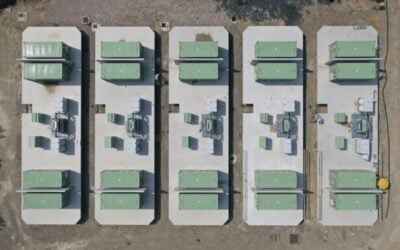OXIS Energy has taken what it describes as a “calculated gamble” on lithium sulfur. Image: Fergus March.
British energy storage company OXIS has claimed that the advent of economically viable solar PV and energy storage technology represents a paradigm shift in developing countries.
Speaking at the launch of the company’s ‘Project Helios’, which aims to serve as a launch pad for cheaper commercial solar energy, Huw Hampson-Jones, the company’s CEO said: “The significance of this technology is at this stage understated. In the continent of Africa for example, this is a breakthrough as profound as the introduction of the mobile phone and allows for the rapid commercialisation of their economies using solar energy storage systems. For Europe, this technology brings a safe and cheap source of electricity for its citizens in a manner that allows its economies to lessen their dependency on oil and gas.”
The company’s Project Helios demonstration consists of a 3.8kWp solar array that is partnered with a 3kWh OXIS Lithium Sulfur battery. The array and storage combo produces 600V DC that is fed into an SMA Sunny Boy Inverter to generate a 240V, 50Hz mains output. Any excess energy generated during the day is stored in the lithium sulfur battery.
Lithium ion and its various subchemistries rule the roost in many areas including consumer electronics and EVs. However as we have seen recently, advanced lithium batteries and even the legacy of lead acid mean that the battle of the chemistries is far from over. Solar Power Portal’s sister site, PV Tech Storage, spoke to Dr Mark Crittenden of OXIS about his company’s work with lithium sulfur last year. He explained why OXIS believes that with a theoretical energy density five times greater than lithium ion, the material is well worth the “calculated gamble” to develop.
Try Premium for just $1
- Full premium access for the first month at only $1
- Converts to an annual rate after 30 days unless cancelled
- Cancel anytime during the trial period
Premium Benefits
- Expert industry analysis and interviews
- Digital access to PV Tech Power journal
- Exclusive event discounts
Or get the full Premium subscription right away
Or continue reading this article for free
OXIS says that up to four 3kWh sulfur batteries can be connected in series to provide 12kWh, which the company claims is suitable for the majority of domestic installations in Europe. However, the company remains excited about the possibility of its storage solution partnered with solar in developing countries and the potential to democratise energy.
Stuart Macfarlane, head of Asia Pacific and storage at global solar company, PROINSO added: “The realisation of the OXIS storage solution is perfectly timed as we continue to move into emerging markets that have a high demand for safe, reliable and cost-effective energy storage solutions.
“Importantly, the technology is robust and easily scalable which is crucial for use across a wide range of applications and in frequently hostile environments. PROINSO is constantly looking for that next innovation which will enable us to continue to deliver technically sophisticated solutions that showcase the best the industry can offer. Working with companies like OXIS in the development of new technologies is the foundation of this ongoing process.”
“
In the continent of Africa for example, this is a breakthrough as profound as the introduction of the mobile phone and allows for the rapid commercialisation of their economies using solar energy storage systems. For Europe, this technology brings a safe and cheap source of electricity for its citizens in a manner that allows its economies to lessen their dependency on oil and gas.
Mark Crittenden, OXIS Energy





